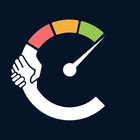xOPS CPU Benchmark﹣FLOPS/MIPS1.1.6


Rating

Genre
GAMES

Size
15.5 MB
Version
1.1.6
Update
Sep 15 2024
xOPS CPU Benchmark﹣FLOPS/MIPS pour Android. Download now!
 Download
Download
The app calculates how many operations (add, subtract, multiply, divide, etc.) a CPU can perform in a given second with either fractional (floating-point) or integer numbers.
FLOPS - Floating-point Operations Per Second, performance measurement of Floating Point Unit (FPU).
INOPS - Integer Operations Per Second, measurement of Arithmetic Logic Unit (ALU)
E.g. 1 G(iga)FLOPS means that CPU can do 1 billion floating-point operations per second (such as 1.1+2.2=3.3).
General app logic is typically reliant on integer operations, while graphics and games rely on floating-point ones. The faster your CPU can crunch numbers, the faster your apps can run.
You can compare your device's performance to 1960s Apollo Guidance Computer or 1990s super computer. There's also a results database with comparison figures for more actual devices (smartphones, laptops).
Tests are executed in single and multithreaded modes and reflect multi-core and single-core performance.
Under Options you can change the number of threads used and choose between 32 and 64 bit precisions.
Stress Test is available and allows tracking CPU performance and temperature over time under high load (determining thermal throttling).
More info about how the app works: https://maxim-saplin.github.io/xOPS-Web/?about=
Source code: https://github.com/maxim-saplin/xOPS-App
xOPS CPU Benchmark is a free, open-source utility designed to evaluate the performance of a computer's central processing unit (CPU). It measures the CPU's floating-point operations per second (FLOPS) and million instructions per second (MIPS), providing valuable insights into the processor's computational capabilities.
FLOPS (Floating-Point Operations Per Second)
FLOPS is a measure of a CPU's ability to perform floating-point calculations, which are essential for scientific, engineering, and graphical applications. xOPS CPU Benchmark measures the CPU's performance in both single-precision (32-bit) and double-precision (64-bit) floating-point operations.
MIPS (Million Instructions Per Second)
MIPS is a measure of a CPU's overall processing speed, indicating how many instructions it can execute per second. xOPS CPU Benchmark measures the CPU's performance in integer operations, which are commonly used in general-purpose applications such as word processing, web browsing, and database management.
Benchmark Methodology
xOPS CPU Benchmark utilizes a comprehensive suite of benchmarks to assess the CPU's performance in various scenarios. These benchmarks include:
* Linpack: A benchmark for solving dense linear systems of equations, commonly used in scientific computing.
* STREAM: A benchmark for measuring memory bandwidth and computational performance.
* Whetstone: A benchmark for measuring the CPU's performance in a range of mathematical operations.
Benchmark Results
The benchmark results are presented in a clear and concise format, displaying the CPU's FLOPS and MIPS scores. These scores can be compared to other CPUs to assess the relative performance of different processors.
Usage
xOPS CPU Benchmark is a straightforward utility to use. It can be run from the command line or through a graphical user interface (GUI). The benchmark process is automated, making it easy to obtain accurate and reliable results.
Benefits
xOPS CPU Benchmark offers several benefits:
* Performance Evaluation: Provides an objective measure of a CPU's performance in FLOPS and MIPS.
* Comparison: Allows for comparison of different CPUs to determine the most suitable processor for specific applications.
* Optimization: Helps in optimizing software and hardware configurations to maximize performance.
* Benchmarking: Enables benchmarking of CPUs over time to track performance improvements or degradation.
Conclusion
xOPS CPU Benchmark is a valuable tool for evaluating the performance of a computer's CPU. By measuring the CPU's FLOPS and MIPS, it provides insights into the processor's computational capabilities and allows for informed decisions regarding hardware selection and software optimization.
4 / 5 ( 643 votes )









